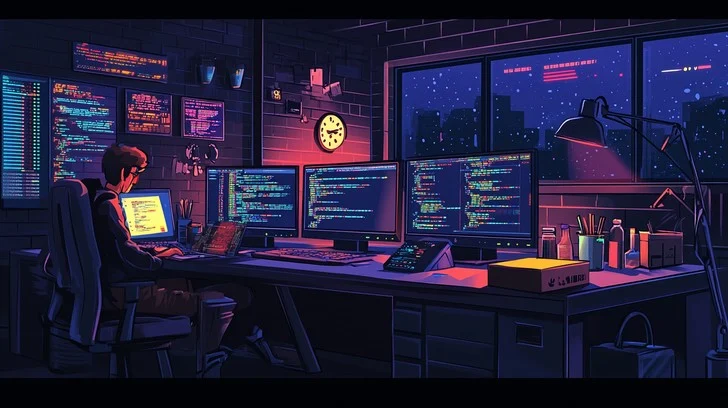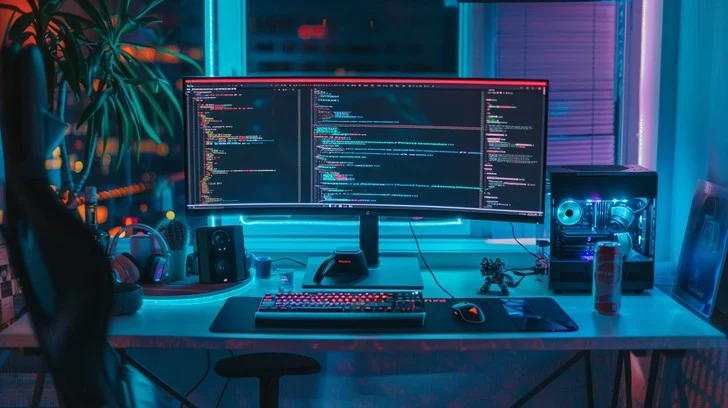Sit back, put on a playlist you love, and picture this: you type a plain-English prompt—“Give me a page with a neon button that rains confetti and plays a lo-fi beat.” Seconds later your browser lights up with exactly that. You tweak the colors, share a live link with friends, and they throw new ideas at you in real time. Welcome to Vibe Coding: What It Is, Why It Exists, and Whether You Should Jump In—the 2025 trend turning software creation into a creative flow session instead of a slog through syntax.
Vibe coding didn’t arise from enterprise committees or computer-science ivory towers. It bubbled up on Twitch streams, Discord co-working rooms, and TikTok highlight reels where code meets DJ culture. Think jam-session energy, instant feedback, and AI copilots that handle the boilerplate, letting you focus on vibes—color palettes, sounds, animations, and quick wins that make you grin. In this deep-dive we’ll explore what vibe coding actually is, why it blew up, how to ride the wave (or why you might steer clear), and practical steps to try your first vibe-coded project tonight.
What Exactly Is Vibe Coding?
Short definition: Vibe coding is the act of building small, fun, or useful software projects in an atmosphere that prioritizes creative flow over perfect engineering. It merges three ingredients:
- AI code companions that turn natural-language requests into runnable snippets.
- Live-preview tooling that updates the screen the moment you press Save, often in the cloud so you skip local installs.
- Mood-boosting rituals—music, RGB lighting, chat interaction—designed to keep momentum and dopamine high.
Traditional coding emphasizes planning, architecture, and long feedback loops. Vibe coding flips that script. It rewards immediacy: see it, tweak it, show it. Think of it as the software equivalent of doodling in a sketchbook or riffing on a guitar lick—except the output can become a real web page, mobile widget, or chatbot in minutes.
Core Principles
- Prompt-First Creation
You begin by describing what you want, not by writing function scaffolding. “Build a minimal to-do list with pastel colors” is enough to get a working start. - Incremental Play
Each small change (color swap, font tweak, sound effect) appears instantly. You follow the fun instead of a rigid spec. - Community & Performance
Many vibe coders livestream or co-code, feeding off viewer suggestions the way musicians feed off a crowd. - Good-Enough Code
Readability and security matter eventually, but the first goal is visible delight. Clean-up can come later.
Why Vibe Coding Exists

Cultural Shift
Younger audiences grew up on instant-gratification platforms—TikTok trends, Twitch reacts, five-second memes. They crave creative outlets that match that tempo. Coding, traditionally seen as slow and technical, felt out of reach until AI and cloud IDEs bridged the gap.
Tooling Breakthroughs
Browser-based editors like Replit, Glitch, and CodeSandbox now spin up full stacks in seconds. AI copilots such as GitHub Copilot Chat, Cursor, or Replit Ghostwriter understand natural language and spit out working HTML/JS/CSS—or Python, Rust, or Liquid—faster than you can type boilerplate.
Low-Code Maturity
Drag-and-drop platforms (Bubble, AppSheet, Wix, Zapier) matured. Instead of walled gardens, they expose code blocks or AI extensions, so vibe coders jump from visual tweaks to code snippets seamlessly.
Remote Socializing
Livestream coding nights, virtual hackathons, and Discord co-working channels exploded during the pandemic. Vibe coding slots perfectly into these social settings: quick prompts, visible wins, minimal prep.
Mental-Health Appeal
Shipping a micro-project in 30 minutes delivers dopamine. Studies connect small, rapid successes with reduced burnout. Vibe coding therefore doubles as a creative hobby and mood booster.
How to Start Vibe Coding Tonight
1. Set the Scene
Put on a playlist—lo-fi beats, synthwave, or whatever sparks flow. Dim the lights or turn on an LED strip. Comfort matters; vibe coding values ambiance.
2. Pick a Zero-Friction Playground
Open Replit, Glitch, Codespaces, or CodeSandbox. These browser IDEs require no local setup. Choose a basic HTML/CSS/JS template (or Python, if you prefer a chatbot flavor).
3. State a Bite-Size Dream
Type into the AI sidebar:
“Create an HTML page with a big neon pink button. When clicked, it should rain confetti and play an 808 kick drum.”
Press enter. Your AI buddy drafts code, often complete with a confetti JavaScript library and an embedded audio element.
4. Tweak and Personalize
Change neon pink to sunset orange. Swap the kick drum for a cat meow. Maybe fade the confetti colors with CSS variables. Each save reloads instantly.
5. Share the Buzz
Replit and Glitch give you a live URL. Send it to friends or drop it in a Discord channel. Viewers might say, “Add sparkles on hover!”—then you implement it live.
6. Optionally Go Live
If you enjoy community vibes, spin up a Twitch Creative Coding stream. Explain each tweak between songs. Chat will throw wilder ideas than you can invent alone.
7. Save Versions
Cloud IDEs let you clone snapshots. Label each major iteration (“rainbow-confetti-version”). If things break, roll back with one click.
8. Publish or Embed
Feeling proud? Embed the widget in your Shopify shop, WordPress blog, or Notion page. Or deploy as a standalone microsite—some vibe coders monetize mini-apps (joke generators, color pickers) on Gumroad.
Should Everyone Vibe Code?

Before you light the RGB and hop in, weigh pros and cons.
Why You Should Try
- Instant Creativity – Perfect for people who feel creative but intimidated by coding depth.
- Low Commitment – Projects can be completed in under an hour.
- Skill Expansion – You absorb real syntax by osmosis; vibe coding is a gateway to deeper coding if you choose.
- Portfolio Boost – Even tiny widgets demonstrate initiative and flair on resumes or socials.
- Community – Friendly chats, high-five emojis, and collab sessions beat coding alone.
Why You Might Skip (for Now)
- Superficial Knowledge – Relying solely on AI can hide real logic; you might struggle when something breaks.
- Security Gaps – AI-generated code can contain vulnerabilities. If you plan to handle sensitive data, involve an experienced developer later.
- Scalability Limits – Vibe-built prototypes often crumble under heavy traffic; rewriting in a robust framework can be inevitable.
- Perfectionist Frustration – If messy code bothers you, vibe sessions can feel chaotic.
- Distraction Risk – Lights and beats can lure you away from deeper learning or serious tasks you can’t postpone.
When to Level Up from Vibe Coding
- A hobby project finds real users—time to add tests, version control, authentication best practices.
- Monetization or client work—privacy policies, accessibility, performance audits become non-negotiable.
- Team adoption—multiple collaborators require Git workflows and coding standards.
Consider vibe coding as a gateway drug: it makes software approachable. Deeper engineering disciplines stand ready when your ambitions outgrow the vibe.
Five FAQs
Is vibe coding only for web pages?
Web is the fastest for visual feedback, but vibe coders also build small games, chatbots, and even MIDI music hacks—anything AI can scaffold quickly.
Do I need fancy gear?
A laptop and browser are enough. RGB lights and mechanical keyboards enhance mood but aren’t prerequisites.
Can vibe coding teach real programming?
Yes—exposure leads to curiosity. Many coders began by tweaking AI snippets, then diving into JS docs to refine.
Is it safe to copy AI code verbatim?
Good practice: read it, sanitize inputs, and avoid handling private data until a pro reviews security.
How do I find communities?
Search “creative coding” on Twitch, join Discord servers like Code & Chill, or follow #vibecoding on X/Twitter.












